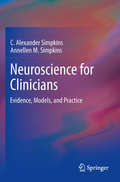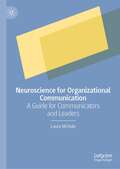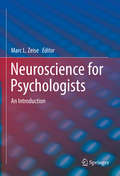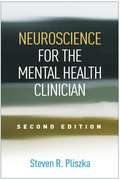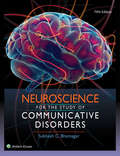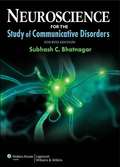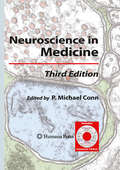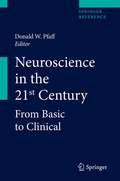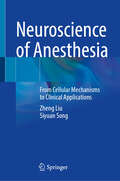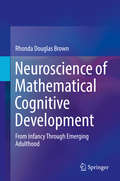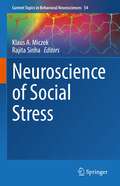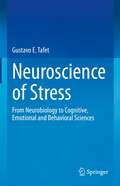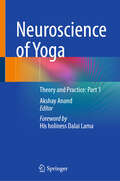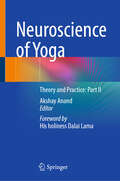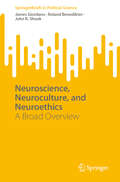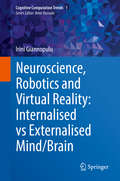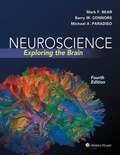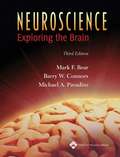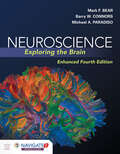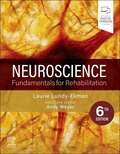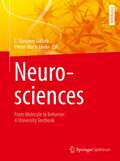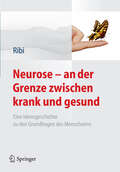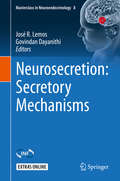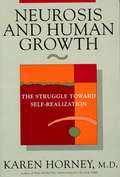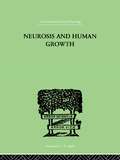- Table View
- List View
Neuroscience for Clinicians
by C. Alexander Simpkins Annellen M. SimpkinsThis book fills the need for an introductory text that opens the field up to the beginner and takes them to higher-level thinking about neuroscience. Neuroscience has captured the interest of students, professionals, and the general public. In fact it is so new, that there are very few books that gather it together in one text. Neuroscience is an amalgamation of many fields: psychology, cognitive science, chemistry, biology, engineering, philosophy, mathematics, and statistics. People who are new to the discipline have to be able to find their way through all of these fields together. In addition, they need to understand the highly technical lexicon, modeling methods, and theoretical assumptions used to describe brain structure, function, and the interaction between them. This book helps readers navigate the conventions used to describe the brain that developed through the years. The authors crystallize the complex modeling methods and technologies so that readers understand what they are saying and how to use them. They address the important underlying principles and important issues of neuroscience, with the debates and discussions that are ongoing as the field evolves. They also include many salient fine-grained details so that the book is not just an overview, but also a useful guide for many levels of readers.
Neuroscience for Organizational Communication: A Guide for Communicators and Leaders
by Laura McHaleOrganizational communication is at a crossroads and professional communicators and leaders alike need to up their game. In this insightful and practical guide, leadership psychologist Dr. Laura McHale shows how neuroscience can help, surveying the field to reveal the science that is most applicable to organizations and providing an evidence-based approach to dramatically boost the effectiveness and impact of communications. From structural dynamics to occupational aprosodia, from the threat (and opportunities) of GPT-3 to the neuroscience of Zoom fatigue, she takes the reader on a fascinating journey of how neuroscience can help unlock the potential of communicators and the organizations they work for.
Neuroscience for Psychologists: An Introduction
by Marc L. ZeiseThis textbook is intended to give an introduction to neuroscience for students and researchers with no biomedical background. Primarily written for psychologists, this volume is a digest giving a rapid but solid overview for people who want to inform themselves about the core fields and core concepts in neuroscience but don’t need so many anatomical or biochemical details given in “classical” textbooks for future doctors or biologists. It does not require any previous knowledge in basic science, such as physics or chemistry. On the other hand, it contains chapters that do go beyond the issues dealt with in most neuroscience textbooks: One chapter about mathematical modelling in neuroscience and another about “tools of neuroscience” explaining important methods. The book is divided in two parts. The first part presents core concepts in neuroscience:Electrical Signals in the Nervous SystemBasics of NeuropharmacologyNeurotransmitters The second part presents an overview of the neuroscience fields of special interest for psychology:Clinical NeuropharmacologyInputs, Outputs and Multisensory ProcessingNeural Plasticity in HumansMathematical Modeling in Neuroscience Subjective Experience and its Neural Basis The last chapter, “Tools of Neuroscience” presents important methodogical approaches in neuroscience with a special focus on brain imaging. Neuroscience for Psychologists aims to fill a gap in the teaching literature by providing an introductory text for psychology students that can also be used in other social sciences courses, as well as a complement in courses of neurophysiology, neuropharmacology or similar in careers outside as well as inside biological or medical fields. Students of data sciences, chemistry and physics as well as engineering interested in neuroscience will also profit from the text.
Neuroscience for the Mental Health Clinician, Second Edition
by Steven R. PliszkaAccessible and succinct, this book has given thousands of clinicians and students the basic understanding of neuroscience that is essential in contemporary mental health practice. Steven R. Pliszka synthesizes current knowledge on the neurobiological bases of major psychiatric disorders. He explores the brain systems that underlie cognition, emotions, and behavior; how disturbances in these systems can lead to psychopathology; and the impact of genetic and environmental risk factors across development. The book also addresses the ways that both pharmacological and psychosocial treatments act on the brain as they bring about a reduction in symptoms. Illustrations include 93 black-and-white figures and 14 color plates. New to This Edition *Incorporates over a decade of important advances in brain science. *Heightened focus on brain networks replaces a deficit-based understanding of disorders. *Cutting-edge discussions of genetics and epigenetics, the biological impact of stress, neurotransmitters, novel depression treatments, and other timely topics. *Detailed chapters on autism spectrum disorder and dementia. *Numerous new and revised figures.
Neuroscience for the Study of Communicative Disorders
by Subhash BhatnagarFocusing on how the science and anatomy of brain processes affect speech and hearing, this updated 5th Edition of Dr. Bahtnagar’s best-selling text offers an easy-to-understand, practical overview of the basics of neuroscience. To provide a comprehensive view of the topic, the book is arranged by systems and structures, with the processes that serve higher mental functions and control speech and hearing covered within specific chapters. In every chapter, the author includes interactive, problem-solving case studies that promote critical thinking and connect neuroscience to the disorders that students will see in practice. Updated to reflect the most recent findings and clinical applications in the field, the 5th Edition and has been meticulously revised to make the study of neuroscience even more user-friendly. Dr. Bhatnagar’s ability to present difficult information in a highly accessible fashion is evident on every page of this beautifully illustrated new edition.
Neuroscience for the Study of Communicative Disorders 4th Edition
by Subhash C. Bhatnagar"Neuroscience for the Study of Communicative Disorders, Fourth Edition" takes a step-by-step, simplified approach, and contains relevant information in its application of neuroscience for students and practitioners in speech-language pathology and audiology--making it the perfect text. It remains an ideal resource that teaches neuroscience fundamentals without encyclopedic details of anatomy and physiology, and reflects the most recent findings and clinical applications.
Neuroscience in Medicine
by P. Michael ConnContinuing progress has been made in understanding the brain at the molecular, anatomic, and physiological levels in the years following the "Decade of the Brain," with the results providing insight into the underlying basis of many neurological disease processes. In Neuroscience in Medicine, Third Edition, a distinguished panel of basic and clinical investigators, noted for their teaching excellence, provide thoroughly updated and revised chapters to reflect these remarkable advances. Designed specifically for medical students and allied health professionals, this up-to-date edition alternates scientific and clinical chapters that explain the basic science underlying neurological processes and then relate that science to the understanding of neurological disorders and their treatment. These popular and now expanded "clinical correlations" cover, in detail, disorders of the spinal cord, neuronal migration, the autonomic nervous system, the limbic system, ocular motility, and the basal ganglia, as well as demyelinating disorders, stroke, dementia and abnormalities of cognition, congenital chromosomal and genetic abnormalities, Parkinson's disease, nerve trauma, peripheral neuropathy, aphasias, sleep disorders and myasthenia gravis. In addition to concise summaries of the most recent biochemical, physiological, anatomical, and behavioral advances, the chapters summarize current findings on neuronal gene expression and protein synthesis at the molecular level. Authoritative and comprehensive, Neuroscience in Medicine, Third Edition provides a fully up-to-date and readily accessible guide to brain functions at the cellular and molecular level, as well as clearly demonstrating their emerging diagnostic and therapeutic importance.
Neuroscience in the 21st Century
by Donald W. PfaffEdited and authored by a wealth of international experts in neuroscience and related disciplines, the aim behind this key new resource is to offer medical students and graduate researchers around the world a comprehensive introduction and overview of modern neuroscience. Neuroscience research is certain to prove a vital element in combating mental illness in its various incarnations, a strategic battleground in the future of medicine, as the prevalence of mental disorders is becoming better understood each year. Hundreds of millions of people worldwide are affected by mental, behavioral, neurological and substance use disorders. The World Health Organization estimated in 2002 that 154 million people globally suffer from depression and 25 million people from schizophrenia; 91 million people are affected by alcohol use disorders and 15 million by drug use disorders. A more recent WHO report shows that 50 million people suffer from epilepsy and 24 million from Alzheimer's and other dementias. Because neuroscience takes the etiology of disease--the complex interplay between biological, psychological, and sociocultural factors--as its object of inquiry, it is increasingly valuable in understanding an array of medical conditions. A recent report by the United States' Surgeon General cites several such diseases: schizophrenia, bipolar disorder, early-onset depression, autism, attention deficit/ hyperactivity disorder, anorexia nervosa, and panic disorder, among many others. Not only is this volume a boon to those wishing to understand the future of neuroscience, it also aims to encourage the initiation of neuroscience programs in developing countries, featuring as it does an appendix full of advice on how to develop such programs. With broad coverage of both basic science and clinical issues, comprising 106 chapters from a diversity of international authors and including complementary video components, Neuroscience in the 21st Century will serve as a comprehensive resource to students and researchers alike.
Neuroscience of Anesthesia: From Cellular Mechanisms to Clinical Applications
by Zheng Liu Siyuan SongThis book provides an in-depth exploration of the intricate relationship between anesthesia and brain function. This comprehensive guide delves into the physiological and pharmacological aspects of neuroanesthesia, highlighting the impact of various anesthetic agents on cerebral dynamics. Key topics include the mechanisms of intracranial pressure regulation, cerebral blood flow, and metabolic processes, alongside advanced brain monitoring techniques such as EEG, evoked potentials, and cerebral oxygenation metrics. Aimed at medical professionals, this book addresses the critical need for enhanced understanding and management of brain physiology during anesthesia. It seeks to solve the challenges of maintaining cerebral homeostasis and preventing neurological complications during surgical procedures. By offering evidence-based insights and practical applications, the book equips anesthesiologists, neurologists, and neurosurgeons with the knowledge to improve patient outcomes.
Neuroscience of Mathematical Cognitive Development: From Infancy Through Emerging Adulthood
by Rhonda Douglas BrownThis book examines the neuroscience of mathematical cognitive development from infancy into emerging adulthood, addressing both biological and environmental influences on brain development and plasticity. It begins by presenting major theoretical frameworks for designing and interpreting neuroscience studies of mathematical cognitive development, including developmental evolutionary theory, developmental systems approaches, and the triple-code model of numerical processing. The book includes chapters that discuss findings from studies using neuroscience research methods to examine numerical and visuospatial cognition, calculation, and mathematical difficulties and exceptionalities. It concludes with a review of mathematical intervention programs and recommendations for future neuroscience research on mathematical cognitive development.Featured neuroscience research methods include:Functional Magnetic Resonance Imaging (fMRI). Diffusion Tensor Imaging (DTI).Event Related Potentials (ERP).Transcranial Magnetic Stimulation (TMS).Neuroscience of Mathematical Cognitive Development is an essential resource for researchers, clinicians and related professionals, and graduate students in child and school psychology, neuroscience, educational psychology, neuropsychology, and mathematics education.
Neuroscience of Social Stress (Current Topics in Behavioral Neurosciences #54)
by Klaus A. Miczek Rajita SinhaSocial stress has emerged as a research front in the neurosciences, and this volume highlights recent insights in brain mechanisms and methodological advances. The topics range from the evolutionary origins of coping with social challenges to neural mechanism-driven focus on novel treatment targets. The parallel presentation of work with animal models and human subjects is bound to be useful to a broad research community.
Neuroscience of Stress: From Neurobiology to Cognitive, Emotional and Behavioral Sciences
by Gustavo E. TafetThis textbook provides an introduction to the interdisciplinary study of stress, helping students and professionals understand the main neurobiological and psychological causes and consequences of stress in human beings. It’s aimed at understanding the concept of stress at different levels, from the impact of environmental stressors to its processing in the brain, and from the neural mechanisms involved in this processing to the expression of different adaptive responses. All these neural mechanisms are clearly explained according to different levels of complexity, from the neurobiological level, including the cellular and molecular mechanisms, to the psychological level, including the cognitive and emotional processing, and behavioral expressions.The whole content is described in a very comprehensive manner, accompanied with descriptive graphics to clearly illustrate every detail, therefore allowing a full integration of all the covered concepts. In addition, clinical expressions of stress, such as mood and anxiety disorders, are also covered in detail, including an overview of different factors of vulnerability and resilience, therefore providing a unique and fundamental insight of this interdisciplinary field. Given its interdisciplinary approach, Neuroscience of Stress: From Neurobiology to Cognitive, Emotional and Behavioral Sciences will provide a comprehensive and clear introduction to the study of stress to students and professionals from different fields of the behavioral and health sciences. It will serve as a valuable text for adoption in classes of a wide range of graduate courses dealing with mental health and well-being, in areas such as health and clinical psychology, health promotion and disease prevention, psychiatry and behavioral medicine, among others.
Neuroscience of Yoga: Theory and Practice: Part 1
by Akshay Anand Pooja NadholtaThis book covers experimental theory and practice of yoga that have enhanced its neuroscientific understanding. This is an excellent handbook for the researchers in the field of evidence-based integrative health. It encompasses traditional and modern tools used in neuroscience. It also provides information for the modern biologists, physicians and policymakers, of how mind-body complexities in neuroscience, mental health and preventive healthcare can be useful for health and disease. It serves as a guide for integrative health practitioners, patients, educationists, philosophers, graduate students and faculty pursuing research in the field of biology, complimentary medicine, and other alternative therapies. The chapters in this book also serve as a comprehensive resource for clinical trials in Yoga. In addition, flow charts and illustrations have been provided to understand how healthy brain ageing can be achieved.
Neuroscience of Yoga: Theory and Practice: Part II
by Akshay Anand Pooja NadholtaThis part of the book offers a multidimensional exploration of the neuroscience of yoga and in-depth insights into the neuroscientific underpinnings of yoga's impact on different disease conditions; explores the fascinating intersections between yoga, education, and neuroeconomics, as well as the relationship between yoga, spirituality, and consciousness; and acknowledges the importance of animal models in yoga research. In addition, the book addresses the concept of mind wandering and knowledge practice gap. This section provides valuable guidance for policymakers, healthcare professionals, and educators by exploring these aspects. Its comprehensive nature makes it an invaluable resource for researchers, practitioners, and individuals interested in unravelling the scientific complexities of the mind-body connection.
Neuroscience, Neuroculture, and Neuroethics: A Broad Overview (SpringerBriefs in Political Science)
by John R. Shook Roland Benedikter James GiordanoContemporary brain research is challenging Western societal norms by questioning basic cornerstones such as individuality, freedom, rationality, solidarity, and the concept of the human being in general. It is giving way to profound changes in Western concepts of culture and civilization. This volume provides a broad overview of the cultural changes incurred by neuroscience and neurotechnology, and explores the evolving fields of neuroeconomics, neuroreligion, neuropolitics, and neuroethics. It takes a multi-disciplinary approach in explaining how neuroscience and neurotechnology will affect society, and illustrates how these tools and methods are being used in research and ever-expanding practices in varying fields. Praise for Neuroscience, Neuroculture, and Neuroethics: A Broad Overview “Giordano, Benedikter and Shook provide an accessible, timely, and engaging introduction to the main challenges of neuroscience and neurotechnology for individuals and society. It is impressively wide-ranging, insightfully examining philosophical, cultural, political, and economic dimensions of brain science. An especially fascinating aspect of the book is discussion of the implications of bioenhancement for transhumanism and how it could influence how we define who we are.” --Walter Glannon, Professor Emeritus of Philosophy, University of Calgary, Canada “This book provides an excellent survey about the challenging ‘Neuro-World’. It reflects the different perspectives which are relevant for modern societies. It is full of information to gather additional knowledge on an international and interdisciplinary level.” --Prof. Dr. Ernst Pöppel, Professor of Medical Psychology, Ludwig Maximilian University (LMU) of Munich, Germany “This engaging and highly accessible book offers an excellent short introduction to the powerful impact of neuroscience and neurotechnology upon modern societies. Covering a broad range of issues and perspectives from neuroscience, social science, philosophy, and ethics, it is eminently suitable for teaching and provides a thought-provoking basis for further discussions.” --Kathinka Evers, Professor of Philosophy, Senior Researcher in Philosophy at the Centre for Research Ethics & Bioethics (CRB) at Uppsala University, Sweden; and Professor Ad Honorem at the Universidad Central de Chile
Neuroscience, Robotics and Virtual Reality: Internalized Vs Externalized Mind/brain (Cognitive Computation Trends #1)
by Irini GiannopuluThis is the first volume in the Cognitive Computation Trends book series, summarising our understanding on the neural correlate of memory, perception-representation, action, language, emotion and consciousness and their mutual interactions. Integrating research in the field of the Neuroscience, Robotics and Virtual Reality, this book is an original and attainable resource that has not been developed in any other writing. In 5 chapters, the author considers that representations are based on allegorical traces and are consciously and/or unconsciously embrained, and that the creation of robots is the expression of the mind. Whole-body virtual motion is thought of as the archetypal expression of virtual reality. Therefore, visual reality is analysed in a context of visuo-vestibular and somesthetic conflict while mixed and augmented reality are scrutinised in a context of visuo-vestibular and somesthetic interaction. This monograph is an indispensable handbook for students and investigators engaged in history of science, philosophy, psychology, neuroscience, engineering and those interested in there interconnections. The ambition of the book is to give students and investigators ideas on which they can build their future research in this new blooming area.
Neuroscience: Exploring The Brain (Fourth Edition)
by Mark F. Bear Michael A. Paradiso Barry W. ConnorsAcclaimed for its clear, friendly style, excellent illustrations, leading author team, and compelling theme of exploration, Neuroscience: Exploring the Brain, 4e takes a fresh, contemporary approach to the study of neuroscience, emphasizing the biological basis of behavior. The authors' passion for the dynamic field of neuroscience is evident on every page, engaging students and helping them master the material. In just a few years, the field of neuroscience has been transformed by exciting new technologies and an explosion of knowledge about the brain. The human genome has been sequenced, sophisticated new methods have been developed for genetic engineering, and new methods have been introduced to enable visualization and stimulation of specific types of nerve cells and connections in the brain. The new Fourth Edition has been fully updated to reflect these and other rapid advances in the field, while honoring its commitment to be student-friendly with striking new illustrations, additional animations, and an unparalleled array of online resources.
Neuroscience: Exploring the Brain (Third Edition)
by Mark F. Bear Barry W. Conners Michael A. ParadisoNeuroscience: Exploring the Brain surveys the organization and function of the human nervous system, presenting material at the cutting edge of neuroscience, in a way that is accessible to both science and nonscience students alike. The book is divided into four parts: Part I, Foundations; Part II, Sensory and Motor Systems; Part III, The Brain and Behavior; and Part IV, The Changing Brain.
Neuroscience: Exploring the Brain, Enhanced Edition
by Mark Bear Barry Connors Michael A. ParadisoAcclaimed for its clear, friendly style, excellent illustrations, leading author team, and compelling theme of exploration, Neuroscience: Exploring the Brain, Fourth Edition takes a fresh, contemporary approach to the study of neuroscience, emphasizing the biological basis of behavior. The authors’ passion for the dynamic field of neuroscience is evident on every page, engaging students and helping them master the material. In just a few years, the field of neuroscience has been transformed by exciting new technologies and an explosion of knowledge about the brain. The human genome has been sequenced, sophisticated new methods have been developed for genetic engineering, and new methods have been introduced to enable visualization and stimulation of specific types of nerve cells and connections in the brain. The Fourth Edition has been fully updated to reflect these and other rapid advances in the field, while honoring its commitment to be student-friendly with striking new illustrati
Neuroscience: Fundamentals For Rehabilitation
by Laurie Lundy-EkmanUse your knowledge of the nervous system to understand and treat neurologic disorders! Neuroscience: Fundamentals for Rehabilitation, 6th Edition provides an illustrated guide to neurology and how it affects the practice of physical and occupational therapy. Case studies and first-person stories from people with neurologic disorders make it easier to develop clinical reasoning skills and apply your knowledge to the clinical setting. This edition includes an enhanced eBook free with each purchase of a new print book. Written by noted PT educator Laurie Lundy-Ekman, Neuroscience uses evidence-based research to help you evaluate and treat clients who have physical limitations due to nervous system damage or disease.
Neurosciences - From Molecule to Behavior: a university textbook
by Pierre-Marie Lledo C. Giovanni GaliziaNeurosciences - a comprehensive approach This textbook covers neuroscience from cellular and molecular mechanisms to behavior and cognitive processing. We also address evolution of the nervous system, computational neuroscience, the history of neuroscience as a discipline and neurophilosophy - to name but a few. The book provides the newest state-of-the-art knowledge about neuroscience from across the animal kingdom, with particular emphasis on model species commonly used in neuroscience labs across the world: mouse, zebra fish, fruit fly, honeybee, and nematode worm. We aim at university students of neuroscience, psychology, biological sciences, and medical sciences, but also computer scientists, philosophers, or anybody interested in understanding how brains work.
Neurose - an der Grenze zwischen krank und gesund
by Alfred RibiNeurotische Störungen sind sehr verbreitet. Freud sagte sogar: "Jedermann ist etwas neurotisch." Man kann natürlich etwas, was in der Bevölkerung dermaßen verbreitet ist, nicht als krankhaft, d.h. als Abweichung von der Norm bezeichnen. Kann man es deshalb aber von "Gesundsein" abgrenzen? So wenig wie eine Frau ein bisschen schwanger sein kann, so wenig kann einer ein bisschen neurotisch sein. Die Jung'sche Auffassung von der Neurose hilft, diagnostisch Klarheit zu schaffen. Dieses Buch ist zunächst ein Buch für Fachleute, es ist aber auch ein "Aufklärungsbuch" für interessierte Laien, das die veralteten Vorurteile über das Wesen der Neurose abbauen hilft. Geschrieben für Psychologen und Psychiater, Absolventen einer Jung'schen Ausbildung, interessierte Laien.
Neurosecretion: Secretory Mechanisms (Masterclass in Neuroendocrinology #8)
by José R. Lemos Govindan DayanithiHow do electrical activity and calcium signals in neurons influence the secretion of peptide hormones? This volume presents the current state of knowledge regarding the electrical, calcium signaling and synaptic properties of neuroendocrine systems from both vertebrate and invertebrate systems. The contributions span in vivo and in vitro studies that address: state‐dependent plasticity, relevance of firing patterns, membrane properties, calcium flux (including dynamic imaging and homeostasis), and molecular mechanisms of exocytosis, including from non-neuronal secretory cells. The chapters focus not only on research results but also on how experiments are conducted using state-of-the-art techniques, and how the resulting data are interpreted.While there are many books on the secretory properties of neurons, this is the first to focus on the distinctive secretory properties of neuroendocrine neurons. Accordingly, it offers an important text for undergraduate and graduate neuroscience students, and will also appeal to established scientists and postdoctoral fellows. This is the eighth volume in the Masterclass in Neuroendocrinology series* - now a co-publication between Springer Nature and the INF (International Neuroendocrine Federation). *Volumes 1-7 published by Wiley
Neurosis and Human Growth: The Struggle Toward Self-Realization
by Karen HorneyDr. Horney discusses the neurotic process as a special form of the human development, the antithesis of healthy growth. She unfolds the different stages of this situation, describing neurotic claims, the tyranny or inner dictates and the neurotic's solutions for relieving the tensions of conflict in such emotional attitudes as domination, self-effacement, dependency, or resignation.
Neurosis and Human Growth: The struggle toward self-realization (International Library Of Psychology Ser.)
by Karen HorneyIn Neurosis and Human Growth, Dr. Horney discusses the neurotic process as a special form of the human development, the antithesis of healthy growth. She unfolds the different stages of this situation, describing neurotic claims, the tyranny or inner dictates and the neurotic's solutions for relieving the tensions of conflict in such emotional attitudes as domination, self-effacement, dependency, or resignation. Throughout, she outlines with penetrating insight the forces that work for and against the person's realization of his or her potentialities. First Published in 1950. Routledge is an imprint of Taylor & Francis, an informa company.
